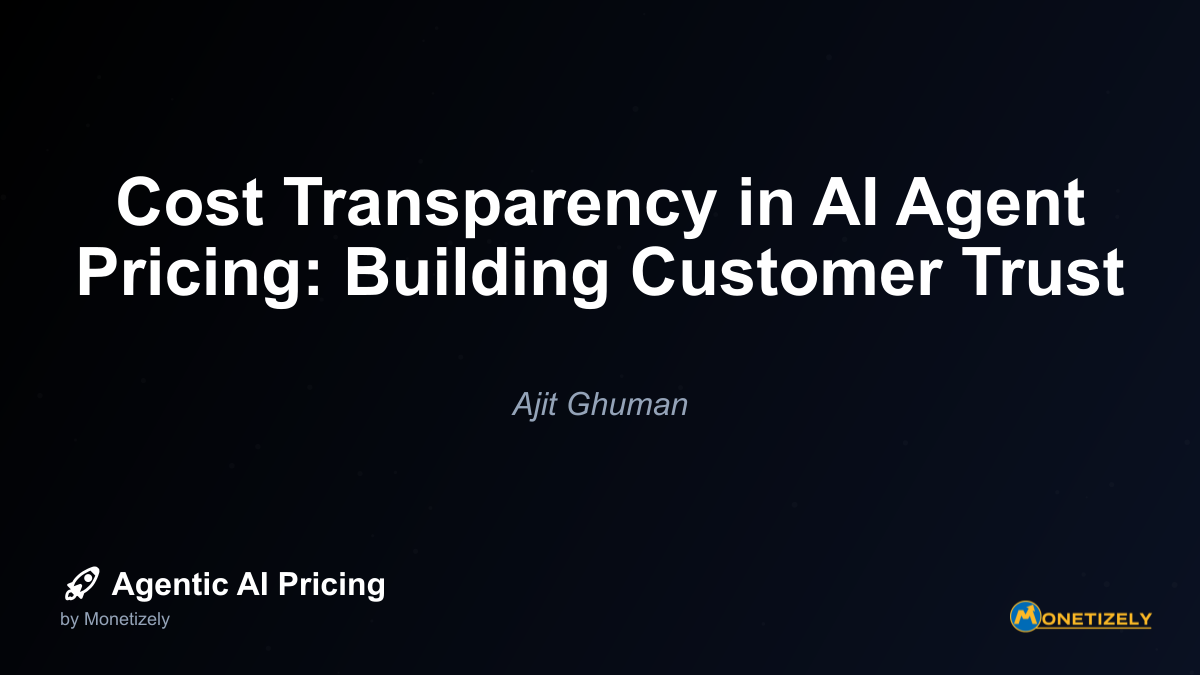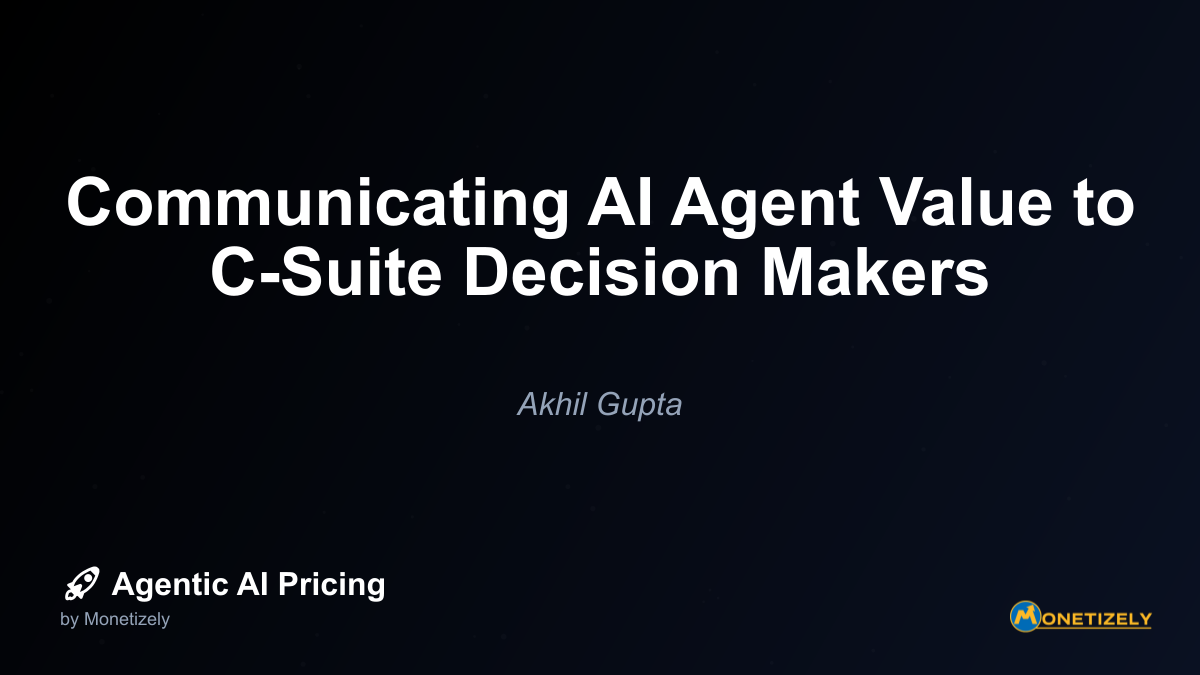· Ajit Ghuman · Communication & Messaging · 8 min read
Cost Transparency in AI Agent Pricing: Building Customer Trust
AI and SaaS Pricing Masterclass
Learn the art of strategic pricing directly from industry experts. Our comprehensive course provides frameworks and methodologies for optimizing your pricing strategy in the evolving AI landscape. Earn a professional certification that can be imported directly to your LinkedIn profile.

Case Studies in AI Pricing Transparency
Case Study 1: Enterprise AI Assistant Provider
A leading enterprise AI assistant provider initially launched with a traditional SaaS pricing model featuring tiered subscriptions based loosely on company size. After six months of sluggish sales cycles and frequent procurement delays, they completely redesigned their pricing approach.
Their new transparent model featured:
- Clear per-user pricing with volume discounts
- Detailed breakdown of included capabilities at each tier
- Usage dashboards showing value delivered in business terms
- Monthly ROI reports comparing AI assistant costs to equivalent human labor
Results: The company reported a 64% reduction in sales cycle length and a 42% increase in conversion rates from trials to paid accounts. Most notably, their average contract value actually increased by 18% despite more transparent pricing—customers were willing to pay more when they clearly understood the value.
Case Study 2: AI Document Processing Solution
An AI-powered document processing solution struggled with customer adoption due to concerns about unpredictable costs. Their initial pricing was based on document volume with surcharges for complex processing requirements—a model that made budgeting difficult for potential customers.
Their transparency transformation included:
- Fixed per-document pricing regardless of complexity
- Pre-implementation assessment to provide accurate cost projections
- Monthly spending caps to prevent budget overruns
- Real-time usage monitoring tools accessible to all stakeholders
Results: Within three months of implementing these changes, the company saw customer acquisition costs decrease by 37% as sales conversations shifted from price haggling to value discussions. Customer retention improved by 28% year-over-year, with existing clients significantly expanding their usage once cost predictability was established.
Practical Strategies for Implementing Transparent AI Agent Pricing
1. Conduct Value-Perception Research
Before establishing transparent pricing, understand how customers perceive and value your AI agent’s capabilities:
- Interview existing customers about their perceived ROI
- Conduct structured surveys comparing different pricing approaches
- Use conjoint analysis to determine which features drive willingness to pay
- Analyze competitor pricing models and customer reactions
This research provides the foundation for pricing communication that resonates with customer value perceptions rather than internal cost structures.
2. Develop Clear Pricing Communication Materials
Effective transparency requires thoughtful communication assets:
- Interactive pricing calculators that show costs under different scenarios
- Case studies highlighting ROI for specific use cases
- Comparison charts showing value relative to human alternatives
- Plain-language explanations of technical pricing components
These materials should be accessible to both technical evaluators and business decision-makers, with language appropriate for each audience.
3. Train Sales Teams in Transparent Communication
Sales representatives need specific training to effectively communicate transparent pricing:
- Techniques for discussing value before price
- Scripts addressing common pricing concerns
- Methods for calculating customer-specific ROI
- Approaches for handling price comparison questions
This training ensures that the transparency philosophy extends throughout the customer journey, not just on the pricing page.
4. Implement Progressive Disclosure
While transparency is valuable, not all pricing details need to be presented simultaneously. Consider a progressive disclosure approach:
- Start with simple, high-level pricing structures
- Provide access to more detailed breakdowns on demand
- Create interactive tools that reveal complexity as needed
- Balance simplicity with depth based on the customer’s stage in the buying journey
This approach prevents cognitive overload while still maintaining transparency principles.
Overcoming Common Objections to Pricing Transparency
Despite its benefits, implementing transparent pricing for AI agents often faces internal resistance. Here’s how to address common objections:
“Transparency Will Hurt Our Negotiation Position”
This concern assumes that pricing power comes from information asymmetry. In reality, especially for novel AI solutions, transparency often strengthens negotiation positions by:
- Shifting discussions from price to value
- Building trust that facilitates larger deals
- Reducing the perceived risk that drives discount requests
- Creating a perception of fairness that supports premium pricing
Rather than weakening negotiating position, transparency often elevates conversations beyond price haggling to strategic value discussions.
”Our Costs Are Too Complex to Explain Simply”
While AI agent costs can involve complex factors, this complexity doesn’t preclude transparency. The solution is to:
- Create simplified models that approximate complex cost drivers
- Develop tiered structures that abstract underlying complexity
- Use analogies and comparisons to make technical factors understandable
- Focus on business outcomes rather than technical inputs
The goal isn’t to expose every nuance of your cost structure, but to provide sufficient clarity for confident decision-making.
”Competitors Don’t Share Their Pricing”
When competitors maintain pricing opacity, transparency becomes a competitive advantage rather than a liability:
- Position transparency as a reflection of customer-centricity
- Highlight the reduced risk of unexpected costs
- Emphasize the ease of budgeting and ROI calculation
- Use transparency to signal confidence in your solution’s value
In markets where opacity is the norm, transparency can serve as a powerful differentiator that attracts risk-averse customers.
How Transparency Affects the Customer Journey
Pricing transparency influences each stage of the AI agent customer journey in distinct ways:
Awareness Stage
During initial discovery, transparency helps potential customers:
- Quickly determine if your solution fits their budget range
- Understand the basic value proposition without sales interaction
- Self-qualify based on realistic pricing expectations
- Share accurate information with other stakeholders
This early clarity prevents wasted time on prospects with misaligned budget expectations while accelerating interest from qualified buyers.
Consideration Stage
As prospects evaluate options more seriously, transparency supports:
- More accurate comparisons between alternative solutions
- Easier internal budget approval processes
- Reduced anxiety about hidden costs or future price increases
- Faster technical and financial evaluations
These benefits significantly compress the consideration timeline, moving qualified prospects to decision more quickly.
Decision Stage
During final decision-making, transparency facilitates:
- Smoother procurement processes with fewer contractual concerns
- More accurate ROI projections that support positive decisions
- Clearer understanding of what constitutes successful implementation
- Stronger alignment between vendor and customer expectations
The result is typically faster closing cycles with fewer last-minute objections or delays.
Implementation and Expansion
Post-purchase, pricing transparency continues to deliver benefits:
- Clearer expansion planning based on known cost structures
- Reduced billing disputes and customer service issues
- Stronger trust supporting additional purchases
- More predictable customer lifetime value
These ongoing advantages translate to higher retention rates and more efficient customer expansion.
Balancing Transparency with Business Requirements
While advocating for transparency, it’s important to acknowledge legitimate business considerations that may affect implementation:
Intellectual Property Protection
Transparency doesn’t require revealing proprietary algorithms or technical implementations. Focus on communicating:
- The outcomes delivered rather than methods used
- The factors that influence pricing without exposing IP
- The value relative to alternatives without detailed cost breakdowns
- The predictability of expenses without revealing margin structures
This approach maintains transparency where it matters to customers while protecting competitive advantages.
Market Segmentation Needs
Different customer segments may have varying price sensitivities or value perceptions. Transparent pricing can accommodate this through:
- Clearly defined industry-specific packages
- Volume-based pricing tiers with transparent thresholds
- Feature differentiation that aligns with segment-specific needs
- Optional add-ons that allow customization without complicating base pricing
These approaches maintain transparency while allowing appropriate price differentiation across segments.
Competitive Dynamics
In highly competitive markets, complete transparency may sometimes create short-term disadvantages. Consider:
- Phased transparency implementation starting with select customer segments
- Transparent pricing frameworks with some negotiable components
- Clear communication about value differentiators that justify premium pricing
- Transparency about pricing methodology even if specific rates vary by customer
These approaches balance competitive needs with the trust benefits of transparency.
Measuring the Impact of Pricing Transparency
To evaluate the effectiveness of transparent pricing strategies, track metrics in four key categories:
Sales Efficiency Metrics
- Average sales cycle length
- Proposal-to-close ratio
- Discount frequency and magnitude
- Sales resource allocation per deal
Customer Acquisition Metrics
- Cost per qualified lead
- Conversion rates at each funnel stage
- Self-service vs. assisted purchasing rates
- Initial contract value
Customer Relationship Metrics
- Net Promoter Score specific to pricing satisfaction
- Billing-related support ticket volume
- Contract renewal rates
- Expansion revenue growth
Financial Performance Metrics
- Customer acquisition cost
- Customer lifetime value
- Gross margin stability
- Revenue predictability
Collectively, these metrics provide a comprehensive view of how pricing transparency affects both customer relationships and business outcomes.
Implementing a Transparency Transformation
For organizations looking to increase pricing transparency for their AI agent offerings, consider this phased approach:
Phase 1: Assessment and Strategy
- Audit current pricing models and customer feedback
- Research competitor approaches and industry benchmarks
- Identify specific transparency gaps and improvement opportunities
- Develop a transparency vision aligned with brand positioning
Phase 2: Internal Alignment
- Secure executive sponsorship for transparency initiatives
- Align sales, marketing, product, and finance teams on approach
- Develop financial models projecting impact of increased transparency
- Create change management plan addressing potential resistance
Phase 3: Communication Development
- Design clear pricing structures and communication frameworks
- Create supporting materials and tools for different audiences
- Develop training for customer-facing teams
- Establish monitoring systems for customer response
Phase 4: Controlled Implementation
- Test transparent approaches with select customer segments
- Gather feedback and refine messaging
- Measure impact against established baselines
- Gradually expand to additional segments based on results
This methodical approach minimizes risk while maximizing the potential benefits of increased transparency.
Conclusion: Transparency as Competitive Advantage
As the AI agent market matures, pricing transparency is evolving from a nice-to-have feature to a critical competitive differentiator. Organizations that embrace transparency gain multiple advantages:
- Shortened sales cycles that reduce acquisition costs
- Increased trust that supports premium pricing
- Improved customer satisfaction driving higher retention
- Clearer value communication enabling market expansion
Most importantly, transparent pricing aligns vendor incentives with customer success—creating sustainable relationships built on mutual understanding rather than information asymmetry.
For AI agent providers, the question is shifting from “Can we afford to be transparent?” to “Can we afford not to be?” As customers become more sophisticated in their AI purchasing decisions, those offering clarity and predictability will increasingly win market share from those clinging to opacity.
The path to transparency may require significant changes to pricing structures, sales approaches, and internal systems. However, the organizations that make this investment now position themselves for leadership in a market where trust is becoming as important as technology.
By building pricing models that customers can understand, predict, and trust, AI agent providers don’t just sell technology—they create the confidence necessary for widespread adoption of these transformative solutions.
Co-Founder & CEO
Ajit is the author of Price To Scale, a top book on SaaS Pricing and is the Founder of Monetizely. Ajit has led and worked in pricing and product marketing at firms like Twilio, Narvar and Medallia. His work has been featured in Forbes and VentureBeat. Ajit regularly consults with software companies from Seed stage to post-IPO on pricing strategy. Ajit is also a highly-rated co-instructor for 'The Art of SaaS Pricing and Monetization' on Maven.
Pricing Strategy Audit
Let our experts analyze your current pricing strategy and identify opportunities for improvement. Our data-driven assessment will help you unlock untapped revenue potential and optimize your AI pricing approach.




